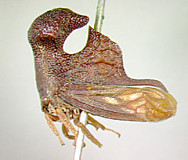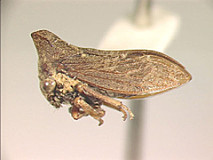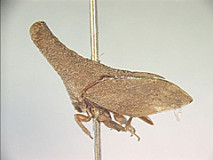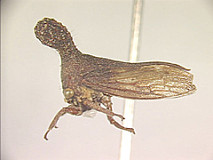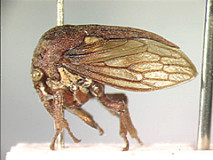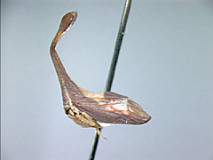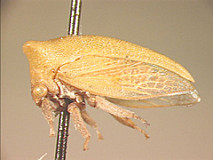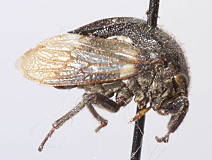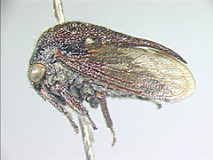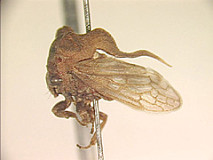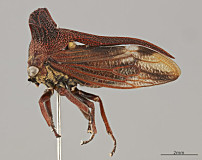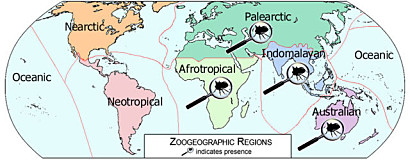Haupt 1929c
Metcalf and Wade 1965a
McKamey 1998a
Day 1999a
Yuan and Chou 2002a
Wallace and Deitz 2004a
Wallace and Deitz 2006a
Evangelista 2021a
Animalia → Arthropoda → Insecta → Pterygota → Hemiptera → Auchenorrhyncha → Cicadomorpha → Membracoidea → Membracidae → Centrotinae
Terentiini Haupt, 1929
Synonyms (and unplaced invalid names)
Bulbaucheniini Goding, 1931, Funkhouserellini Yuan and Zhang, in Yuan and Chou, 2002
Selected references
Overview
Wallace and Deitz (2004a) gave a revised definition and description of the tribe Terentiini, which makes up nearly the entire native treehopper fauna of Australia, but includes also genera elsewhere in the Australian, Indomalayan and Palearctic regions. More recently, Wallace and Deitz (2006a) presented a phylogenetic analysis of the tribe with a discussion of its biogeography and host plant associations. Evangelista (2021) added a new genus, Wallaciana, to the tribe.
Taxon images
Terentiini
Distribution
Diagnostic characters
Pronotum with or without suprahumeral horns (in some, these present at apex of median anterior horn); median anterior horn present in Bulbauchenia, Eutryonia, Funkhouserella, and Pyrgonota, posterior process straight at base, appressed against scutellum and usually concealing it (exceptions: scutellum visible in Bulbauchenia, Wallaciana, and some Sextius), significantly extending past m-cu3 crossvein of forewing (exception: not surpassing m-cu3 in Pyrgonota). Scutellum short (with abdomen removed, at most acute scutellar apices visible). Male style clasp laterally oriented, thickened dorsally, membranous ventrally, usually quadrate (acuminate apically in Bulbauchenia and Pyrgonota), angled ventrally; style shank broadened ventrally before midpoint and arched just beyond.
Chromosome numbers
Male 2n = 21.
Taxonomic constituents
Acanthucalis Evans, 1966 Evans, 1966
Acanthuchus Stål, 1866 Stål, 1866
Alocanthella Evans, 1966 Evans, 1966
Alocebes Evans, 1966 Evans, 1966
Alosextius Evans, 1996 Evans, 1996
Anzac Distant, 1916 Distant, 1916
Arimanes Distant, 1916 Distant, 1916
Bucktoniella Evans, 1966 Evans, 1966
Bulbauchenia Schumacher, 1915 Schumacher, 1915
Bunyella Day, 1999 Day, 1999
Cebes Distant, 1916 Distant, 1916
Ceraon Buckton, 1903 Buckton, 1903
Crito Distant, 1916 Distant, 1916
Daymfus Özdikmen and Demir, 2010 Özdikmen and Demir, 2010
Dingkana Goding, 1903 Goding, 1903
Eufairmairia Distant, 1916 Distant, 1916
Eufairmairiella Evans, 1966 Evans, 1966
Eufrenchia Goding, 1903 Goding, 1903
Eutryonia Goding, 1903 Goding, 1903
Evansiana McKamey, 1994 McKamey, 1994
Funkhouserella Schmidt, 1926 Schmidt, 1926
Goddefroyinella Distant, 1916 Distant, 1916
Lubra Goding, 1903 Goding, 1903
Matumuia Day, 1999 Day, 1999
Neocanthuchus Day, 1999 Day, 1999
Neosextius Day, 1999 Day, 1999
Otinotoides Distant, 1916 Distant, 1916
Pogonella Evans, 1966 Evans, 1966
Pogonotypellus Evans, 1966 Evans, 1966
Polonius Distant, 1916 Distant, 1916
Protinotus Day, 1999 Day, 1999
Pyrgonota Stål, 1870 Stål, 1870
Rentzia Day, 1999 Day, 1999
Rigula Day, 1999 Day, 1999
Sarantus Stål, 1863 Stål, 1863
Sertorius Stål, 1866 Stål, 1866
Sextius Stål, 1866 Stål, 1866
Terentius Stål, 1866 Stål, 1866
Undarella Day, 1999 Day, 1999
Wallaciana Evangelista, 2021 Evangelista, 2021
Yangupia Day, 1999 Day, 1999
Prepared by
Matthew S. Wallace, Lewis L. Deitz, and Mark J. Rothschild, 26 November 2021.


